Cub cadet RZT-S46, RZT-S54, RZT-S42 User Manual
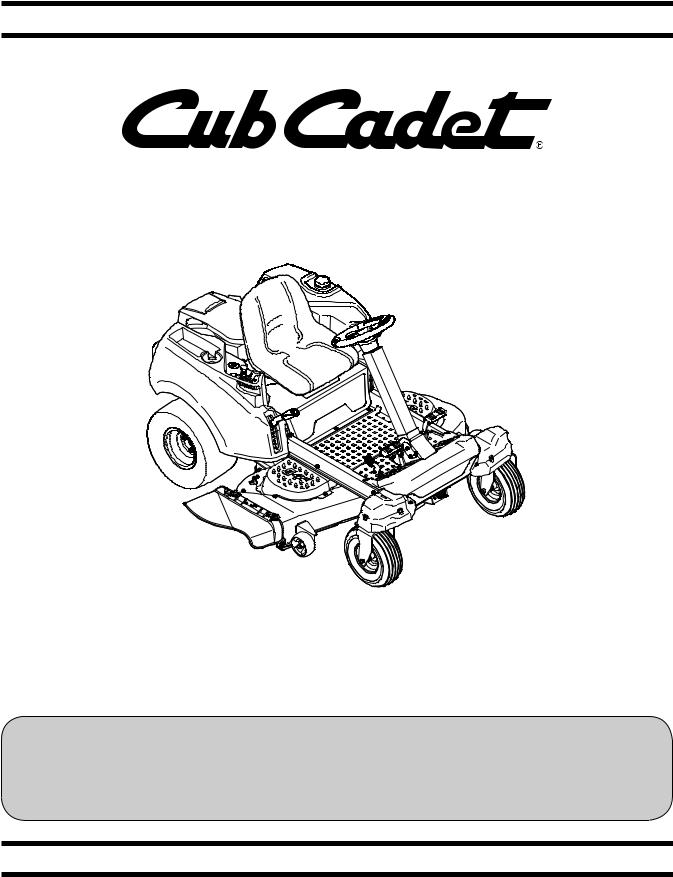
Safe Operation Practices • Set-Up • Operation • Maintenance • Service • Troubleshooting • Warranty
Operator’s Manual
RZT-S
 WARNING
WARNING
READ AND FOLLOW ALL SAFETY RULES AND INSTRUCTIONS IN THIS MANUAL
BEFORE ATTEMPTING TO OPERATE THIS MACHINE.
FAILURE TO COMPLY WITH THESE INSTRUCTIONS MAY RESULT IN PERSONAL INJURY.
CUB CADET LLC, P.O. BOX 361131 CLEVELAND, OHIO 44136-0019
Printed In USA |
Form No. 769-08504A |
|
(April 19, 2013) |
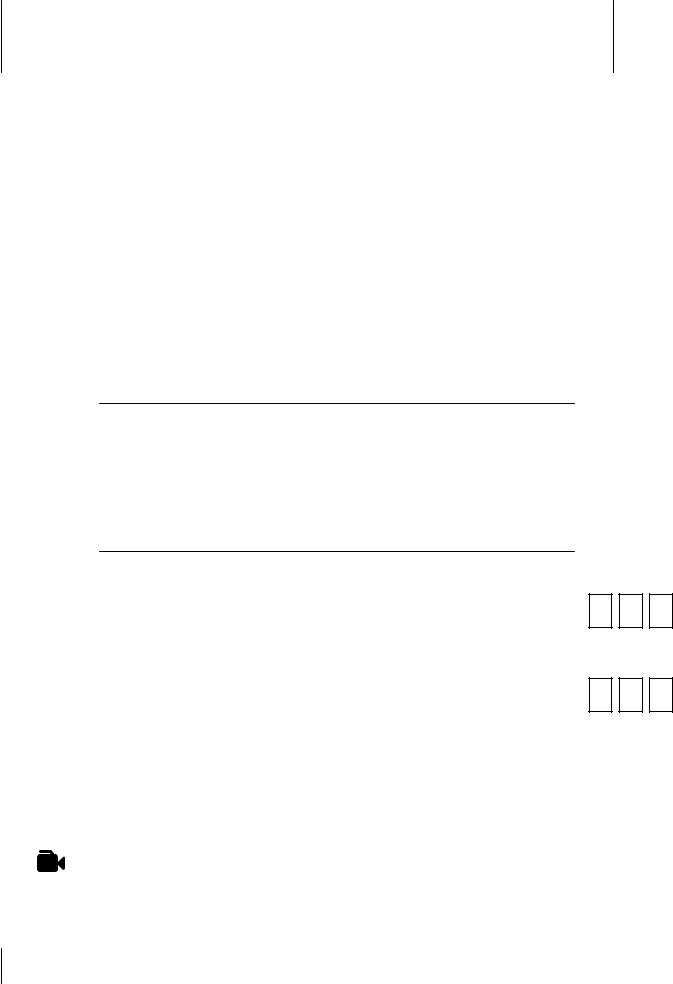
To The Owner
Thank You
Thank you for purchasing a Cub Cadet Zero-Turn Tractor. It was carefully engineered to provide excellent performance when properly operated and maintained.
Please read this entire manual prior to operating the equipment. It instructs you how to safely and easily set up, operate and maintain your machine. Please be sure that you, and any other persons who will operate the machine, carefully follow the recommended safety practices at all times. Failure to do so could result in personal injury or property damage.
All information in this manual is relative to the most recent product information available at the time of printing. Review this manual frequently to familiarize yourself with the machine, its features and operation. Please be aware that this Operator’s
Manual may cover a range of product specifications for various models. Characteristics and features discussed and/or illustrated in this manual may not be applicable to all models. We reserve the right to change product specifications, designs and equipment without notice and without incurring obligation.
1
If applicable, the power testing information used to establish the power rating of the engine equipped on this machine can be found at www.opei.org or the engine manufacturer’s web site.
If you have any problems or questions concerning the machine, phone your local Cub Cadet dealer or contact us directly. Cub
Cadet’s Customer Support telephone numbers, website address and mailing address can be found on this page. We want to ensure your complete satisfaction at all times.
Throughout this manual, all references to right and left side of the machine are observed from the operating position
The engine manufacturer is responsible for all engine-related issues with regards to performance, power-rating, specifications, warranty and service. Please refer to the engine manufacturer’s Owner’s/Operator’s Manual, packed separately with your machine, for more information.
Table of Contents
Safe Operation Practices......................................... |
3 |
Service..................................................................... |
25 |
Assembly & Set-Up................................................... |
9 |
Troubleshooting...................................................... |
31 |
Controls & Features................................................ |
13 |
Replacement Parts................................................. |
32 |
Operation................................................................ |
16 |
Attachments & Accessories................................... |
34 |
Maintenance & Adjustment................................. |
20 |
Warranties.............................................................. |
38 |
Record Product Information |
Model Number |
|
|
|
|
|
|
|
|
|||||||||
Before setting up and operating your new equipment, please |
|
|
|
|
|
|
|
|
|
|
|
|
|
|
|
|
|
|
|
|
|
|
|
|
|
|
|
|
|
|
|
|
|
|
|
||
locate the model plate on the equipment and record the |
|
|
|
|
|
|
|
|
|
|
|
|
|
|
|
|
|
|
information in the provided area to the right. You can locate the |
|
|
|
|
|
|
|
|
|
|
|
|
|
|
|
|
|
|
|
|
|
|
|
|
|
|
|
|
|
|
|
|
|
|
|
||
model plate by standing at the left side of the tractor, pivoting |
Serial Number |
|
|
|
|
|
|
|
|
|||||||||
the seat forward and looking down at the seat frame. This |
|
|
|
|
|
|
|
|
||||||||||
information will be necessary, should you seek technical support |
|
|
|
|
|
|
|
|
||||||||||
|
|
|
|
|
|
|
|
|
||||||||||
via our web site or with your local Cub Cadet dealer. |
|
|
|
|
|
|
|
|
|
|
|
|
|
|
|
|
|
|
|
|
|
|
|
|
|
|
|
|
|
|
|
|
|
|
|
||
|
|
|
|
|
|
|
|
|
|
|
|
|
|
|
|
|
|
|
|
|
|
|
|
|
|
|
|
|
|
|
|
|
|
|
|
|
|
Product Registration and Customer Support
Please register your product on our website, www.cubcadet.com.
If you have difficulty assembling this product or have any questions regarding the controls, operation, or maintenance of this machine, you can seek help from the experts. Choose from the options below:
◊Visit us on the web at www.cubcadet.com
See How-to Maintenance and Parts Installation Videos at www.cubcadet.com/tutorials
◊Locate your nearest Cub Cadet Dealer at (877) 282-8684
◊Write to Cub Cadet LLC • P.O. Box 361131 • Cleveland, OH • 44136-0019
2
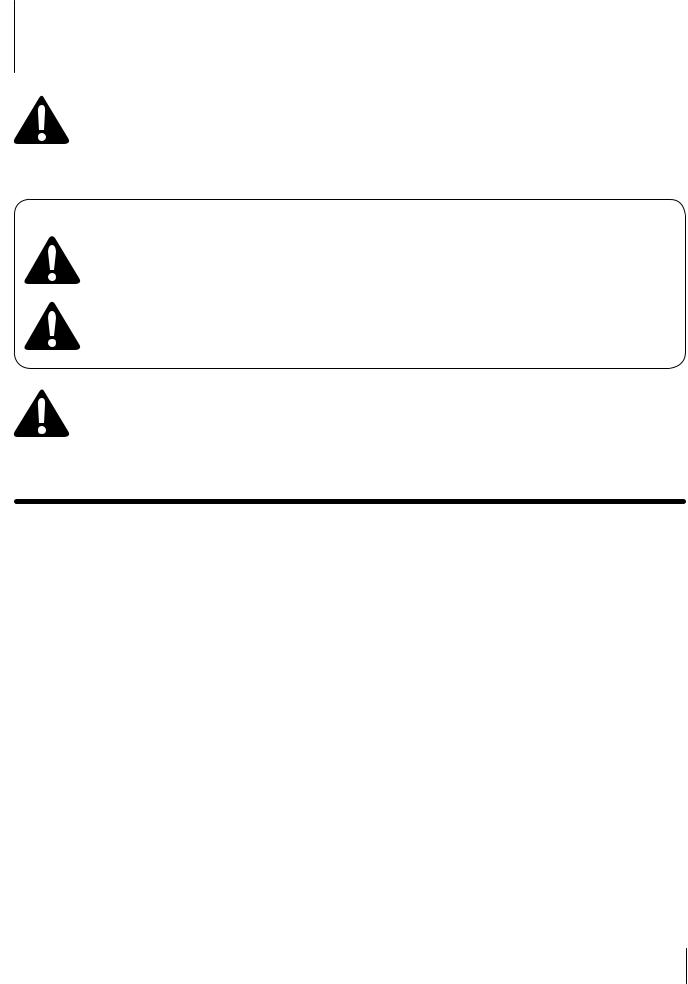
Important Safe Operation Practices |
2 |
|
|
|
|
WARNING! This symbol points out important safety instructions which, if not followed, could endanger the personal safety and/or property of yourself and others. Read and follow all instructions in this manual before attempting to operate this machine. Failure to comply with these instructions may result in personal injury.
When you see this symbol. HEED ITS WARNING!
CALIFORNIA PROPOSITION 65
WARNING! Engine Exhaust, some of its constituents, and certain vehicle components contain or emit chemicals known to State of California to cause cancer and birth defects or other reproductive harm.
WARNING! Battery posts, terminals, and related accessories contain lead and lead compounds, chemicals known to the State of California to cause cancer and reproductive harm. Wash hands after handling
DANGER! This machine was built to be operated according to the safe operation practices in this manual. As with any type of power equipment, carelessness or error on the part of the operator can result in serious injury. This machine is capable of amputating hands and feet and throwing objects. Failure to observe the following safety instructions could result in serious injury or death.
General Operation
1.Read, understand, and follow all instructions on the machine and in the manual(s) before attempting to assemble and operate. Keep this manual in a safe place for future and regular reference and for ordering replacement parts.
2.Be familiar with all controls and their proper operation.
Know how to stop the machine and disengage them quickly.
3.Never allow children under 14 years of age to operate this machine. Children 14 and over should read and understand the instructions and safe operation practices in this manual and on the machine and should be trained and supervised by an adult.
4.Never allow adults to operate this machine without proper instruction.
5.To help avoid blade contact or a thrown object injury, keep bystanders, helpers, children and pets at least 75 feet from the machine while it is in operation. Stop machine if anyone enters the area.
6.Thoroughly inspect the area where the equipment is to be used. Remove all stones, sticks, wire, bones, toys, and other foreign objects which could be picked up and thrown by the blade(s). Thrown objects can cause serious personal injury.
7.Plan your mowing pattern to avoid discharge of material toward roads, sidewalks, bystanders and the like. Also, avoid discharging material against a wall or obstruction which may cause discharged material to ricochet back toward the operator.
8.Always wear safety glasses or safety goggles during operation and while performing an adjustment or repair to protect your eyes. Thrown objects which ricochet can cause serious injury to the eyes.
9.Wear sturdy, rough-soled work shoes and close-fitting slacks and shirts. Loose fitting clothes and jewelry can be caught in movable parts. Never operate this machine in bare feet or sandals.
10.Be aware of the mower and attachment discharge direction and do not point it at anyone. Do not operate the mower without the discharge cover or entire grass catcher in its proper place.
11.Do not put hands or feet near rotating parts or under the cutting deck. Contact with the blade(s) can amputate hands and feet.
3
12.A missing or damaged discharge cover can cause blade contact or thrown object injuries.
13.Stop the blade(s) when crossing gravel drives, walks, or roads and while not cutting grass.
14.Watch for traffic when operating near or crossing roadways. This machine is not intended for use on any public roadway.
15.Do not operate the machine while under the influence of alcohol or drugs.
16.Mow only in daylight or good artificial light.
17.Never carry passengers.
18.Back up slowly. Always look down and behind before and while backing to avoid a back-over accident. Be aware and pay attention to the safety system function that stops power to the blades when driving in reverse. If not
fuctioning properly, contact an authorized dealer for safety system inspection and repair.
19.Slow down before turning. Operate the machine smoothly.
Avoid erratic operation and excessive speed.
20.Disengage blade(s), set parking brake, stop engine and wait until the blade(s) come to a complete stop before removing grass catcher, emptying grass, unclogging chute, removing any grass or debris, or making any adjustments.
21.Never leave a running machine unattended. Always turn off blade(s), place drive control levers in neutral, set parking brake, stop engine and remove key before dismounting.
22.Use extra care when loading or unloading the machine into a trailer or truck. This machine should not be driven up or down ramp(s), because the machine could tip over, causing serious personal injury. The machine must be pushed manually on ramp(s) to load or unload properly.
23.Muffler and engine become hot and can cause a burn. Do not touch.
24.Check overhead clearances carefully before driving under low hanging tree branches, wires, door openings etc., where the operator may be struck or pulled from the machine, which could result in serious injury.
25.Disengage all attachment clutches, set the parking brake to the ‘ON’ position.
26.Your machine is designed to cut normal residential grass of a height no more than 10”. Do not attempt to mow through unusually tall, dry grass (e.g., pasture) or piles of dry leaves. Dry grass or leaves may contact the engine exhaust and/ or build up on the mower deck presenting a potential fire hazard.
27.Use only accessories and attachments approved for this machine by the machine manufacturer. Read, understand and follow all instructions provided with the approved accessory or attachment.
28.Data indicates that operators, age 60 years and above, are involved in a large percentage of riding mower-related injuries. These operators should evaluate their ability
to operate the riding mower safely enough to protect themselves and others from serious injury.
29.If situations occur which are not covered in this manual, use care and good judgment. Contact your customer service representative for assistance.
Slope Operation
Slopes are a major factor related to loss of control and tip-over accidents which can result in severe injury or death. All slopes require extra caution. If you cannot back up the slope or if you feel uneasy on it, do not mow it.
For your safety, use the slope gauge included as part of this manual to measure slopes before operating this machine on a sloped or hilly area. If the slope is greater than 15 degrees as
shown on the slope gauge, do not operate this machine on that area or serious injury could result.
Do:
1.Mow across slopes, not up and down. Exercise extreme caution when changing direction on slopes.
2.Watch for holes, ruts, bumps, rocks, or other hidden objects. Uneven terrain could overturn the machine. Tall grass can hide obstacles.
3.Use slow speed. Choose a low enough speed so that you will not have to stop while on the slope. Avoid starting or stopping on a slope. If the tires are unable to maintain traction, disengage the blades and proceed slowly and carefully straight down the slope.
4.Follow the manufacturer’s recommendations for wheel weights or counterweights to improve stability.
5.Use extra care with grass catchers or other attachments. These can change the stability of the machine.
6.Keep all movement on the slopes slow and gradual. Do not make sudden changes in speed or direction. Rapid acceleration or deceleration could cause the front of the machine to lift and rapidly flip over backwards, which could cause serious injury.
Do Not:
1.Do not turn on slopes unless necessary; then turn slowly uphill and use extra care while turning.
2.Do not mow near drop-offs, ditches or embankments. The mower could suddenly turn over if a wheel is over the edge of a cliff, ditch, or if an edge caves in.
3.Do not try to stabilize the machine by putting your foot on the ground.
4.Do not use a grass catcher on steep slopes.
5.Do not mow on wet grass. Reduced traction could cause sliding.
6.Do not tow heavy pull behind attachments (e.g. loaded dump cart, lawn roller, etc.) on slopes greater than 5 degrees. When going down hill, the extra weight tends to push the tractor and may cause you to lose control (e.g. tractor may speed up, braking and steering ability are reduced, attachment may jack-knife and cause tractor to overturn).
4 |
|
Section 2 — Important Safe Operation Practices |
|
||
|
|
|
Children
1.Tragic accidents can occur if the operator is not alert to the presence of children. Children are often attracted to the machine and the mowing activity. They do not understand the dangers. Never assume that children will remain where you last saw them.
a.Keep children out of the mowing area and in watchful care of a responsible adult other than the operator.
b.Be alert and turn machine off if a child enters the area.
c.To avoid back-over accidents, always look behind and down for small children.
d.Never carry children, even with the blade(s) shut off. They may fall off and be seriously injured or interfere with safe machine operation.
e.Use extreme care when approaching blind corners, doorways, shrubs, trees or other objects that may block your vision of a child who may run into the path of the machine.
f.Keep children away from hot or running engines. They can suffer burns from a hot muffler.
g.Remove key when machine is unattended to prevent unauthorized operation.
2.Never allow children under 14 years of age to operate this machine. Children 14 and over should read and understand the instructions and safe operation practices in this manual and on the machine and should be trained and supervised by an adult.
Towing
1.Tow only with a machine that has a hitch designed for towing. Do not attach towed equipment except at the hitch point.
2.Follow the manufacturers recommendation for weight limits for towed equipment and towing on slopes.
3.Never allow children or others in or on towed equipment.
4.On slopes, the weight of the towed equipment may cause loss of traction and loss of control.
5.The maximum weight on the hitch is 50 lbs. and the maximum towed load is 250 lbs.
6.Never allow passengers on the towed equipment.
7.Loss of traction can occur on slopes, 5° (9 %) maximum grade.
8.Travel slowly and allow extra distance to stop.
9.Use caution during turns to avoid jack-knifing.
10.Use extra caution when operating in reverse.
11.Do not modify or repair the hitch, replace the hitch if damaged.
12.Travel slowly and allow extra distance to stop.
13.Do not shift to neutral and coast downhill.
Service
Safe Handling of Gasoline:
1.To avoid personal injury or property damage use extreme care in handling gasoline. Gasoline is extremely flammable and the vapors are explosive. Serious personal injury can occur when gasoline is spilled on yourself or your clothes which can ignite. Wash your skin and change clothes immediately.
a.Use only an approved gasoline container.
b.Never fill containers inside a vehicle or on a truck or trailer bed with a plastic liner. Always place containers on the ground away from your vehicle before filling.
c.When practical, remove gas-powered equipment from the truck or trailer and refuel it on the ground. If this is not possible, then refuel such equipment on a trailer with a portable container, rather than from a gasoline dispenser nozzle.
d.Keep the nozzle in contact with the rim of the fuel tank or container opening at all times until fueling is complete. Do not use a nozzle lock-open device.
e.Extinguish all cigarettes, cigars, pipes and other sources of ignition.
f.Never fuel machine indoors.
g.Never remove gas cap or add fuel while the engine is hot or running. Allow engine to cool at least two minutes before refueling.
h.Never over fill fuel tank. Fill tank to no more than ½” below bottom of filler neck to allow space for fuel expansion.
i.Replace gasoline cap and tighten securely.
j.If gasoline is spilled, wipe it off the engine and equipment. Move machine to another area. Wait 5 minutes before starting the engine.
k.To reduce fire hazards, keep machine free of grass, leaves, or other debris build-up. Clean up oil or fuel spillage and remove any fuel soaked debris.
l.Never store the machine or fuel container inside where there is an open flame, spark or pilot light as on a water heater, space heater, furnace, clothes dryer or other gas appliances.
m.Allow a machine to cool at least five minutes before storing.
General Service
1.Never run an engine indoors or in a poorly ventilated area. Engine exhaust contains carbon monoxide, an odorless, and deadly gas.
2.Before cleaning, repairing, or inspecting, make certain the blade(s) and all moving parts have stopped. Disconnect the spark plug wire(s) and ground against the engine to prevent unintended starting.
Section 2 — Important Safe Operation Practices |
|
5 |
|
||
|
|
|

3.Periodically check to make sure the blades come to complete stop within approximately (5) five seconds after operating the blade disengagement control. If the blades do not stop within the this time frame, your machine should be serviced professionally by an authorized dealer.
4.Regularly check the safety interlock system for proper function, as described later in this manual. If the safety interlock system does not function properly, have your machine serviced professionally by an authorized dealer.
5.Check the blade(s) and engine mounting bolts at frequent intervals for proper tightness. Also, visually inspect blade(s) for damage (e.g., excessive wear, bent, cracked). Replace the blade(s) with the original equipment manufacturer’s (O.E.M.) blade(s) only, listed in this manual. “Use of parts which do not meet the original equipment specifications may lead to improper performance and compromise safety!”
6.Mower blades are sharp. Wrap the blade or wear gloves, and use extra caution when servicing them.
7.Keep all nuts, bolts, and screws tight to be sure the equipment is in safe working condition.
8.Never tamper with the safety interlock system or other safety devices. Check their proper operation regularly.
9.After striking a foreign object, stop the engine, disconnect the spark plug wire(s) and ground against the engine. Thoroughly inspect the machine for any damage. Repair the damage before starting and operating.
10.Never attempt to make adjustments or repairs to the machine while the engine is running.
11.Grass catcher components and the discharge cover are subject to wear and damage which could expose moving parts or allow objects to be thrown. For safety protection, frequently check components and replace immediately with original equipment manufacturer’s (O.E.M.) parts only, listed in this manual. “Use of parts which do not meet the original equipment specifications may lead to improper performance and compromise safety!”
12.Do not change the engine governor settings or over-speed the engine. The governor controls the maximum safe operating speed of the engine.
13.Maintain or replace safety and instruction labels, as necessary.
14.Observe proper disposal laws and regulations for gas, oil, etc. to protect the environment.
15.According to the Consumer Products Safety Commission (CPSC) and the U.S. Environmental Protection Agency (EPA), this product has an Average Useful Life of seven (7) years,
or 270 hours of operation. At the end of the Average Useful Life have the machine inspected annually by an authorized service dealer to ensure that all mechanical and safety systems are working properly and not worn excessively. Failure to do so can result in accidents, injuries or death.
Do not modify engine
To avoid serious injury or death, do not modify engine in any way. Tampering with the governor setting can lead to a runaway engine and cause it to operate at unsafe speeds. Never tamper with factory setting of engine governor.
Notice Regarding Emissions
Engines which are certified to comply with California and federal
EPA emission regulations for SORE (Small Off Road Equipment) are certified to operate on regular unleaded gasoline, and may include the following emission control systems: Engine
Modification (EM) and Three Way Catalyst (TWC) if so equipped.
When required, models are equipped with low permeation fuel lines and fuel tanks for evaporative emission control. California models may also include a carbon canister. Please contact Customer Support for information regarding the evaporative emission control configuration for your model.
Spark Arrestor
WARNING! This machine is equipped with an internal combustion engine and should not be used on or near any unimproved forest-covered, brushcovered or grass-covered land unless the engine’s exhaust system is equipped with a spark arrestor meeting applicable local or state laws (if any).
If a spark arrestor is used, it should be maintained in effective working order by the operator. In the State of California the above is required by law (Section 4442 of the California Public
Resources Code). Other states may have similar laws. Federal laws apply on federal lands.
A spark arrestor for the muffler is available through your nearest engine authorized service dealer or contact the service department, P.O. Box 361131 Cleveland, Ohio 44136-0019.
6 |
|
Section 2 — Important Safe Operation Practices |
|
||
|
|
|
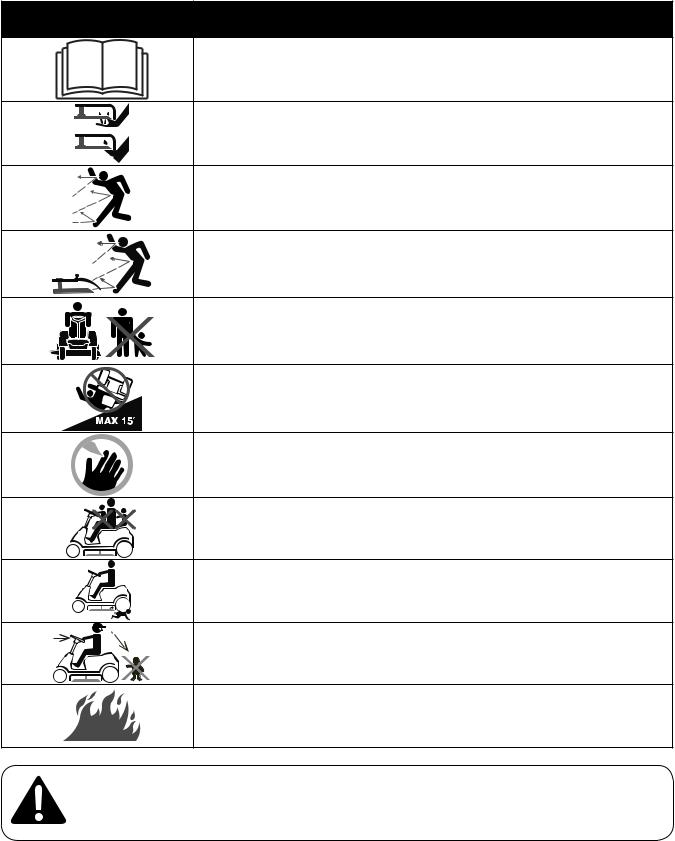
Safety Symbols
This page depicts and describes safety symbols that may appear on this product. Read, understand, and follow all instructions on the machine before attempting to assemble and operate.
Symbol |
Description |
READ THE OPERATOR’S MANUAL(S)
Read, understand, and follow all instructions in the manual(s) before attempting to assemble and operate
WARNING— ROTATING BLADES
Do not put hands or feet near rotating parts or under the cutting deck. Contact with the blade(s) can amputate hands and feet.
WARNING—THROWN OBJECTS
This machine may pick up and throw and objects which can cause serious personal injury.
WARNING—THROWN OBJECTS
This machine may pick up and throw and objects which can cause serious personal injury.
BYSTANDERS
Keep bystanders, helpers, children and pets at least 75 feet from the machine while it is in operation.
WARNING— SLOPE OPERATION
Do not operate this machine on a slope greater than 15 degrees.
DANGER — ROTATING BLADES
To reduce the risk of injury, keep hands and feet away. Do not operate unless discharge cover or grass catcher is in its proper place. If damaged, replace immediately.
DANGER— ROTATING BLADES
Never carry passengers. Never carry children, even with the blades off.
DANGER— ROTATING BLADES
To avoid a back-over accident, keep children away from the machine while it is in operation.
DANGER— ROTATING BLADES
Always look down and behind before and while backing to avoid a back-over accident.
WARNING—GASOLINE IS FLAMMABLE
Allow the engine to cool at least two minutes before refueling.
WARNING! Your Responsibility — Restrict the use of this power machine to persons who read, understand and follow the warnings and instructions in this manual and on the machine.
SAVE THESE INSTRUCTIONS!
Section 2 — Important Safe Operation Practices |
|
7 |
|
||
|
|
|
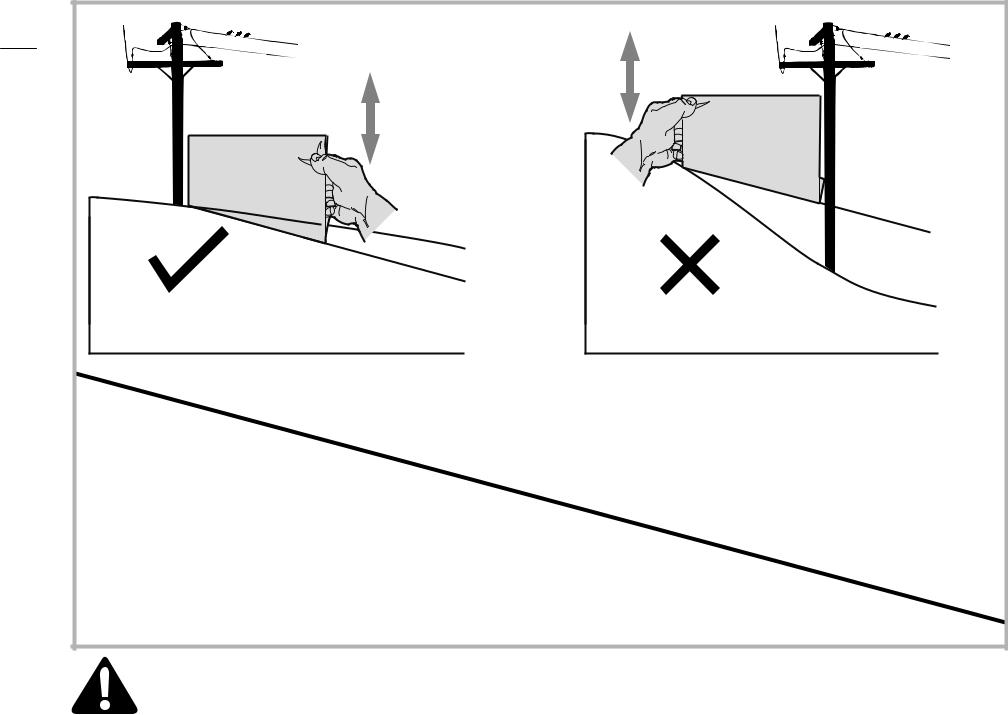
racticesP perationO afeS — 2 ectionS 8
Slope Gauge
15° Slope
(OK)
Slope |
(TOO STEEP) |
Figure 1 |
Figure 2 |
15°
dashed line
USE THIS SLOPE GAUGE TO DETERMINE
IF A SLOPE IS TOO STEEP FOR SAFE OPERATION!
To check the slope, proceed as follows:
1.Remove this page and fold along the dashed line.
2.Locate a vertical object on or behind the slope (e.g. a pole, building, fence, tree, etc.)
3.Align either side of the slope gauge with the object (See Figure 1 and Figure 2 ).
4.Adjust gauge up or down until the left corner touches the slope (See Figure 1 and Figure 2).
5.If there is a gap below the gauge, the slope is too steep for safe operation (See Figure 2 above).
WARNING! Slopes are a major factor related to tip-over and roll-over accidents which can result in severe injury or death.
Do not operate machine on slopes in excess of 15 degrees. All slopes require extra caution.
Always mow across the face of slopes, never up and down slopes.
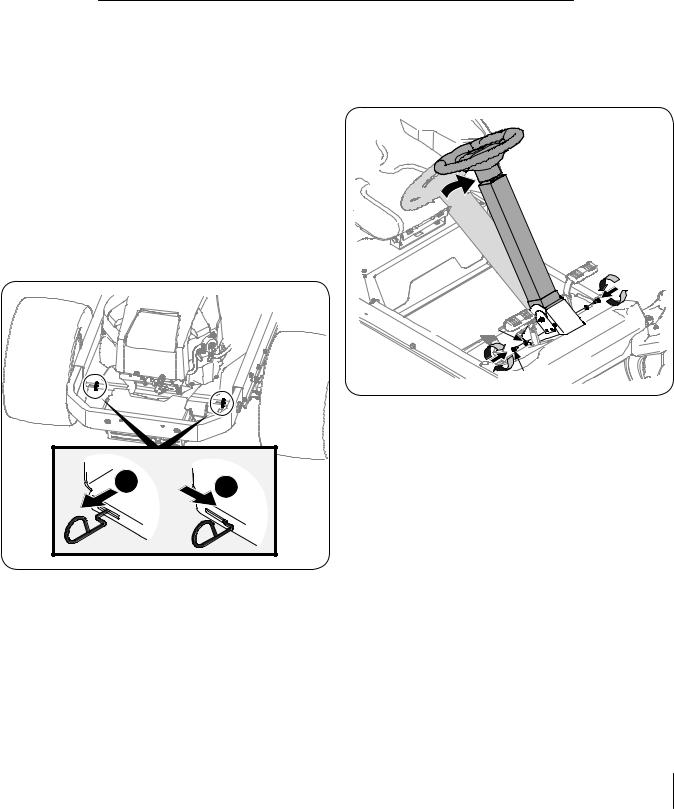
Assembly & Set-Up |
3 |
|
|
|
|
Contents of Crate |
|
• |
One Lawn Tractor |
• |
One Deck Wash Hose Coupler |
• |
One Operator’s Manual |
• |
One Engine Operator’s Manual |
• |
Two Hex Screws and Flat Washers |
|
|
Tractor Preparation
1.Remove the upper crating material from the shipping pallet, and cut any bands or tie straps securing the tractor to the pallet.
2.If the deck is not in the highest mowing position (pulled all the way back), use the deck lift handle to raise the deck to its highest position. Refer to the Controls & Features section for instructions on raising and lowering the deck.
3.Disengage the parking brake.
4.Engage the transmission bypass rods on each side of the tractor; then carefully roll the tractor off the shipping pallet. The transmission bypass rods (one for each the RH and LH transmission) are located on the rear of the tractor, just inside each rear wheel. Engage the bypass rods by pulling each one out and to the right then letting it return to lock it into place. See Figure 3-1.
Steering Wheel Column
The steering wheel column is tilted all the way back for shipping.
1.Place the steering column in one of the two positions and secure in place with the hex screws and flat washers packed seperately. See Figure 3-2.
Flat Washer
 Hex Screw
Hex Screw
Figure 3-2
a |
b |
|
|
|
Figure 3-1 |
5.Disengage the bypass rods after rolling the tractor off the pallet. See Figure 3-1.
6.Remove the deck wash system nozzle adapter from the manual bag and store for future use.
9

Steering Wheel
1.Remove the hardware for attaching the steering wheel from beneath the steering wheel cap. Carefully pry off the steering wheel cover to remove the hardware.
2.With the wheels of the tractor pointing straight forward, place the steering wheel over the steering shaft.
3.Place the flat washer and belleville washer over the steering wheel and secure with the hex screw. See Figure 3-3.
Steering Wheel Cover
Install Operator’s Seat
To install the seat proceed as follows:
NOTE: The seat is shipped with the seat switch and seat pan attached. A second person may be needed to hold the seat.
1.Cut any straps securing the seat assembly to the tractor. Remove any packing material.
NOTE: Be careful not to cut the wiring harness connecting the seat and the seat switch in the bottom of the seat.
2.Remove the two shoulder screws and flange lock nuts in the seat pan as shown in Figure 3-4.
Hex Screw 
 Steering Wheel
Steering Wheel
Belleville Washer
Steering Wheel 
Column
Figure 3-3
4.Place the steering wheel cover over the center of the steering wheel and push downward until it “clicks” into place.
Shoulder Screws
Flange Lock Nuts
Figure 3-4
3.Rotate the seat into position and secure the seat into place with the previously removed shoulder screws and flange lock nuts. Be careful not to crimp or damage the wire harness while installing the seat. See Figure 3-5.
Shoulder Screws
Flange Lock Nuts
Figure 3-5
NOTE: Be sure to push the excess wire from the wire harness into the seat box hole before continuing.
10 Section 3— Assembly & Set-Up
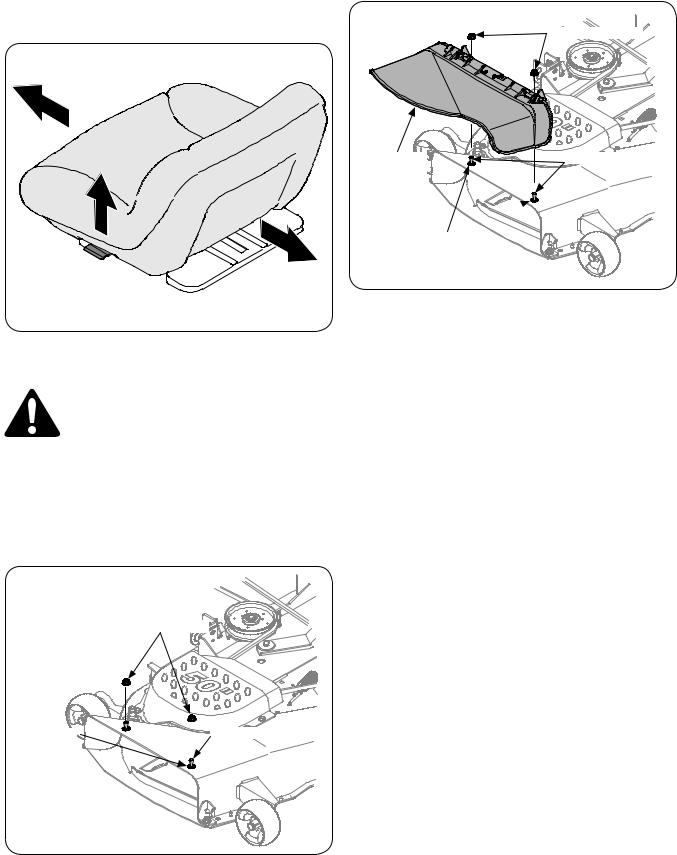
Adjusting the Seat
To adjust the position of the seat, lift the seat adjustment lever up. Slide the seat forward or rearward to the desired position; then release the adjustment lever. Make sure seat is locked into position before operating the tractor. See Figure 3-6.
3.Install the discharge chute deflector using the carriage bolts, push nuts and flange lock nuts as shown in Figure
3-8 and securely tighten the hardware.
50” Deck |
Flange Lock Nuts |
Shown |
Discharge |
Carriage Bolts |
Chute |
|
Deflector |
|
Push Nuts
Figure 3-8
Figure 3-6
Lower Deck Discharge Chute Deflector
WARNING! Never operate the mower deck without the chute deflector installed and in the down position.
The discharge chute deflector must be installed before operating the mower.
1.Remove the keys that are attached with a zip tie to the chute bracket.
2.Remove the flange lock nuts from the deck. Do not remove the push nuts or carriage bolts, leaving them in place will aid in installing the chute. See Figure 3-7.
50” Deck
Shown
Flange Lock Nuts
Push Nuts 

 Carriage Bolts
Carriage Bolts
Figure 3-7
Section 3 — Assembly & Set-Up |
|
11 |
|
||
|
|
|
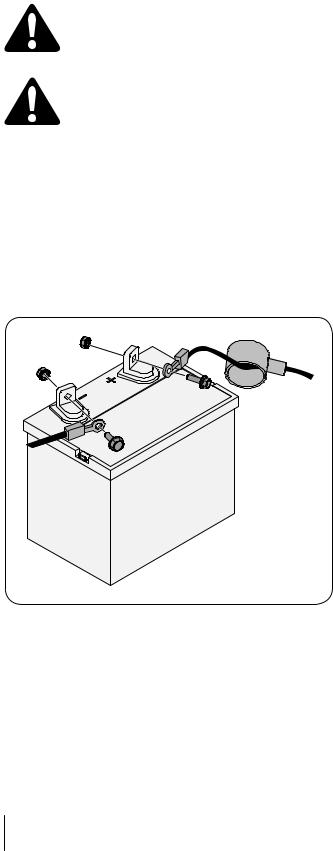
Fuel Fill-Up
Using a good grade of unleaded regular gasoline, fill the tank (beside the engine on the left side of the mower). When the fuel tank reaches one inch from the top of the tank, stop, DO NOT OVERFILL. Space must be left for expansion.
Connecting the Battery Cables
CALIFORNIA PROPOSITION 65 WARNING!
Battery posts, terminals, and related accessories contain lead and lead compounds, chemicals known to the State of California to cause cancer and reproductive harm. Wash hands after handling.
CAUTION: When attaching battery cables, always connect the POSITIVE (Red) wire to its terminal first,
followed by the NEGATIVE (Black) wire.
For shipping reasons, both battery cables on your equipment may have been left disconnected from the terminals at the factory. To connect the battery cables, proceed as follows:
NOTE: The positive battery terminal is marked Pos. (+). The negative battery terminal is marked Neg. (–).
NOTE: If the positive battery cable is already attached, skip ahead to step 2.
1.Remove the plastic cover, if present, from the positive battery terminal and attach the red cable to the positive battery terminal (+) with the bolt and hex nut. See Figure
3-9.
Figure 3-9
2.Remove the plastic cover, if present, from the negative battery terminal and attach the black cable to the negative battery terminal (–) with the bolt and hex nut. See Figure 3-9.
3.Position the red rubber boot over the positive battery terminal to help protect it from corrosion.
NOTE: If the battery is put into service after the date shown on top/side of battery, charge the battery as instructed in the
Maintenance section your Operator’s Manual prior to operating the tractor.
12 Section 3— Assembly & Set-Up
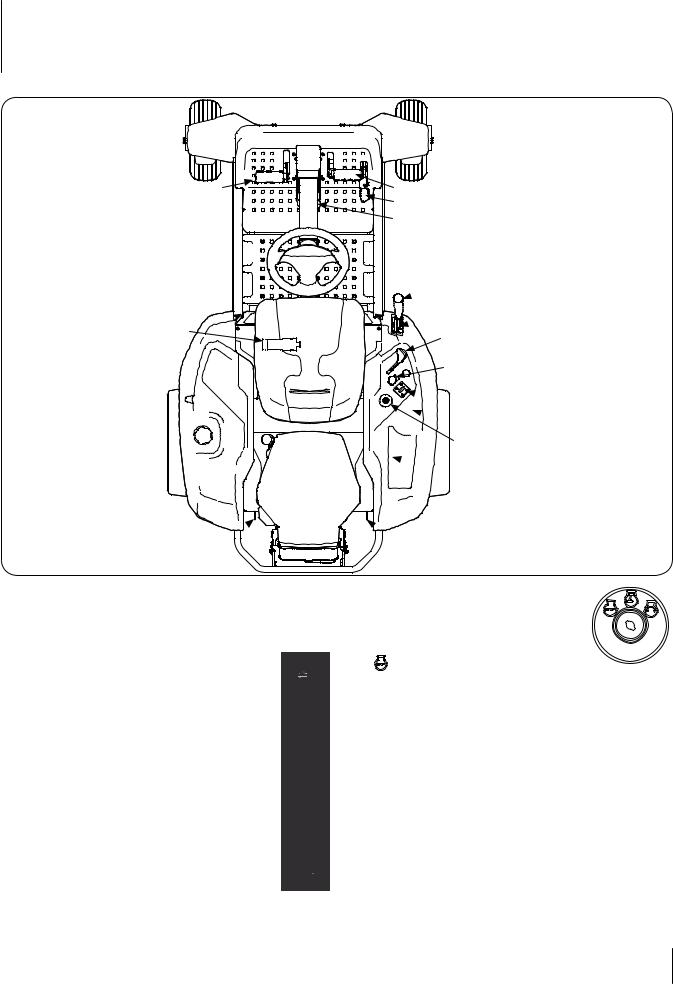
Controls & Features |
4 |
|
|
|
|
Brake Pedal |
Forward Drive Pedal |
Reverse Drive Pedal |
Parking Brake/Cruise Control Lever |
Steering Wheel 











 Deck Lift Handle
Deck Lift Handle
Seat Adjustment Lever
Fuel Tank Cap 

Transmission Bypass Valves 
NOTE: References to LEFT, RIGHT, FRONT, and REAR indicate that position on the tractor when facing forward while seated in the operator’s seat.
Deck Height Index |
|
|
The deck height index consists of eight index notches |
|
|
located on the front/right of the console. Each notch |
LO |
|
|
||
corresponds to a 1⁄2” change in the deck height position |
1 |
|
|
||
ranging from 1-1⁄2” at the lowest notch to 4” at the |
2 |
|
highest notch. |
3 |
|
Deck Lift Handle |
||
4 |
||
The deck lift handle is located on the front/right of the |
5 |
|
console, and is used to raise and lower the mower deck. |
6 |
|
Pull the handle to the left out of the index notch and push |
||
7 |
||
downward to lower the deck, or pull upward to raise the |
8 |
|
deck. When the desired height is attained, move the lift |
||
DECK |
||
handle to the right until fully in the index notch. |
||
|
HI |
|
|
HEIGHT |

 Deck Height Index
Deck Height Index
Throttle/Choke Control
PTO Knob
 Hour Meter/Indicator Panel
Hour Meter/Indicator Panel
 Cup Holder
Cup Holder
Ignition Switch
 Storage Tray
Storage Tray
 Transmission Bypass Valves
Transmission Bypass Valves
Ignition Switch
The ignition switch is located on the LH console to the right of the operator’s seat. The ignition switch has three positions as follows:
STOP — The engine and electrical system is turned off.
RUN  — The tractor electrical system is energized.
— The tractor electrical system is energized.
START  — The starter motor will turn over the engine. Release the key immediately when the engine starts
— The starter motor will turn over the engine. Release the key immediately when the engine starts
NOTE: To prevent accidental starting and/or battery discharge, remove the key from the ignition switch when the tractor is not in use.
13
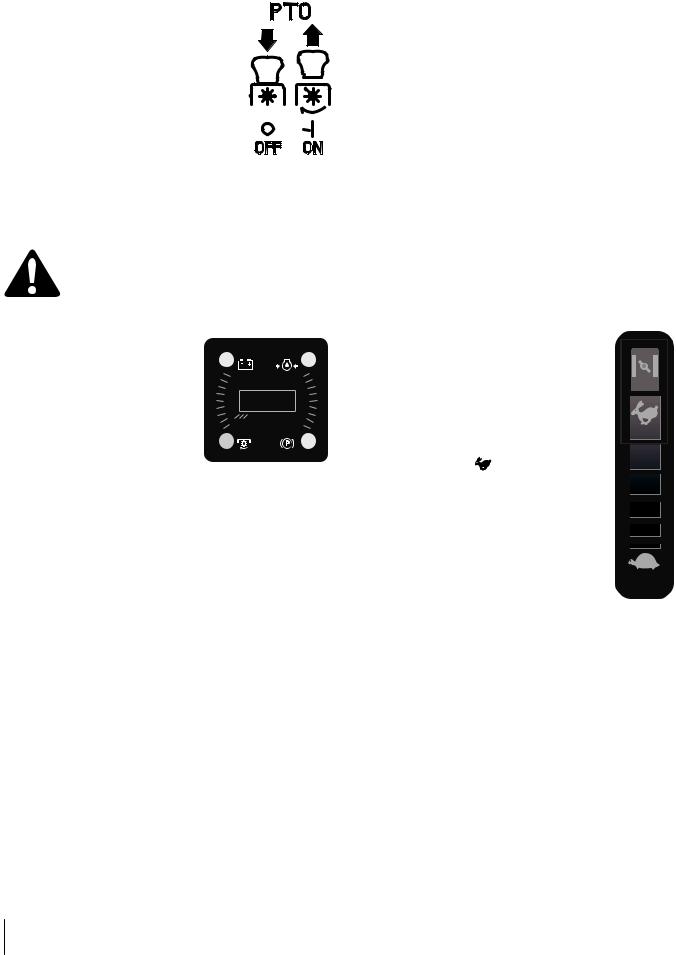
PTO Knob
The PTO (Power Take-Off) knob is located on the RH console to the right of the operator’s seat.
The PTO knob operates the electric PTO clutch mounted on the bottom of the engine crankshaft. Pull the knob upward to engage the PTO clutch, or push the knob downward to
disengage the clutch.
The PTO knob must be in the “disengaged” position when starting the engine.
Fuel Tank Cap
The fuel tank cap is located on the left console. Turn the fill cap to remove. Always re-install the fuel cap tightly onto the fuel tank after removing.
WARNING! Never fill the fuel tank when the engine is running. If the engine is hot from recently running, allow to cool for several minutes before refueling. Highly flammable gasoline could splash onto the engine and cause a fire.
Hour Meter/Indicator Panel
The hour meter/indicator panel is located on the RH console to the right of the operator’s seat.
Hour Meter Features
The hour meter records the hours that the tractor has been operated in the digital display (tenths of an hour - right most digit).
BATT. |
OIL |
HOURS 1/10
PTO / |
PARK |
BLADE |
BRAKE |
NOTE: The hour meter is activated whenever the ignition switch is turned to the RUN position. Keep a record of the actual hours of operation to assure all maintenance procedures are completed
position. Keep a record of the actual hours of operation to assure all maintenance procedures are completed
according to the instructions in this manual and the engine manual.
When key is turned to the RUN  position, the battery indicator light briefly illuminates and the battery voltage is briefly displayed. The display then changes to the accumulated hours.
position, the battery indicator light briefly illuminates and the battery voltage is briefly displayed. The display then changes to the accumulated hours.
The Indicator Monitor will also remind the operator of maintenance intervals for changing the engine oil. The LCD will alternately flash,
“CHG” ; “OIL” and the recorded hours for five minutes after every 50 hours of recorded operation. The maintenance interval lasts for two hours (from 50-52, 100-102, 150-152, etc.). The LCD will flash as described for five minutes every time the tractor’s engine is started during this maintenance interval. Follow the oil change intervals provided in the engine manual.
Indicator Panel Features
Battery Indicator
Illuminates and the battery voltage is displayed briefly when the ignition switch is turned to the RUN  position.
position.
Illuminates to indicate the battery voltage has dropped below
11.5 (+0.5/-1.0) volts. The battery voltage is also displayed on the hour meter. If this indicator and display come on during operation, check the battery and charging system for possible causes and/or contact your Cub Cadet dealer.
Oil Pressure Indicator (If Engine So Equipped)
This warning lamp indicates low engine oil pressure. If the indicator comes on while the engine is running, stop the engine immediately and check for possible causes. Do not run the engine while this indicator is illuminated. Contact your Cub Cadet dealer to have the tractor and engine inspected.
NOTE: The oil pressure indicator may illuminate when the ignition switch is in the RUN  position, but should turn off when the engine is started.
position, but should turn off when the engine is started.
PTO Engaged Indicator
This indicator illuminates when the PTO is engaged and the ignition switch is turned to the START  position. Check this indicator if the engine will not crank with the ignition switch in the START
position. Check this indicator if the engine will not crank with the ignition switch in the START  position. If necessary, disengage the PTO.
position. If necessary, disengage the PTO.
Parking Brake Engaged Indicator
This indicator illuminates when the parking brake is in the DISENGAGED position and the ignition switch is turned to the START  position. Check this indicator if the engine will not crank with the ignition switch in the START
position. Check this indicator if the engine will not crank with the ignition switch in the START  position. If necessary, engage the parking brake.
position. If necessary, engage the parking brake.
Throttle/Choke Control
The throttle/choke control is located on the RH console to the right of the operator’s seat. When set
in a given position, a uniform engine speed will be |
CHOKE |
|
|
maintained. |
|
•Push the throttle/choke control lever forward
to increase the engine speed. The tractor is |
FAST |
|
designed to operate with the throttle/choke |
|
|
control in the FAST |
position when the |
|
tractor is being driven and the mower deck is engaged.
• Pull the throttle/choke control lever rearward to decrease the engine speed.
• When starting the engine, push the control lever fully forward into the CHOKE position.
position.
• |
After starting and warming the engine, move |
SLOW |
|
the control lever rearward until you feel it |
|
|
move past the choke detent. |
|
14 Section 4— Controls & Features
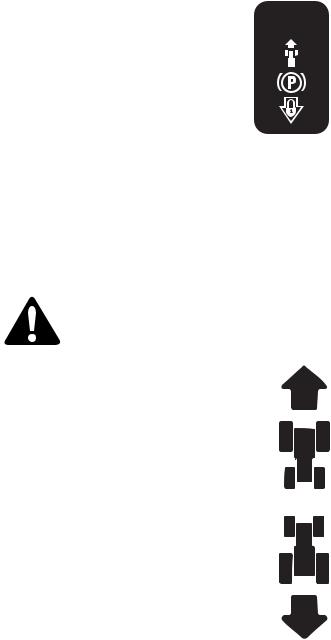
Parking Brake/ |
PARK BRAKE/ |
|||||
Cruise Control Lock Pedal |
||||||
CRUISE CTRL. |
||||||
LOCK PEDAL |
||||||
The parking brake/cruise control lock pedal is |
|
|
|
|
|
|
located at the base of the steering column. It |
|
|
|
|
|
|
|
|
|
|
|
||
is used to engage the parking brake when the |
|
|
|
|
|
|
tractor is at rest. Engaging the lever while the |
I23746 |
|||||
tractor is in motion allows the tractor to remain |
||||||
|
|
|
|
|
||
at a constant ground speed without applying |
|
|
|
|
|
|
pressure to the forward drive pedal. Refer to
the Operation section of this manual for detailed instructions regarding the parking brake as well as the cruise control feature.
NOTE: Cruise control can NOT be engaged at the tractor’s fastest ground speed. If the operator should attempt to do so, the tractor will automatically decelerate to the fastest optimal mowing ground speed
NOTE: The parking brake must be set if the operator leaves the seat with the engine running or the engine will automatically shut off.
WARNING! Never leave a running machine unattended. Always disengage PTO, set parking brake, stop engine and remove key to prevent unintended starting.
Forward Drive Pedal
The forward drive pedal is located on the right side of the tractor, along the running board. Press the forward drive pedal forward to cause the tractor to travel forward. Ground speed is also controlled with the forward drive pedal. The further forward the pedal is pivoted, the faster the tractor will travel. The pedal will return to its original position when it’s not pressed.
Reverse Pedal
The reverse drive pedal is located on the right side of the tractor along the running board. Ground speed is also controlled with the reverse drive pedal. The further downward the pedal is pivoted, the faster the tractor will travel. The pedal will return to its original position when it’s not pressed.
Transmission Bypass Valves
The transmission bypass valves (one for each the RH and LH transmission) are located under the tractor on the back of each transmission inside the rear wheels.
When engaged, the two valves open a bypass within the hydrostatic transmissions, which allows the tractor to be pushed short distances by hand. Refer to the Assembly & Set-Up section for instructions on using the bypass feature.
Cup Holder
The cup holder is located on the RH console to the right of the operator’s seat.
Storage Tray
The storage tray is located at the rear of the RH console.
Seat Adjustment Lever
The seat adjustment lever is located below the left side of the seat. The lever allows for adjustment of the fore to aft position of the operator’s seat. Refer to the Assembly & Set-Up section for instructions on adjusting the seat position.
Section 4 — Controls & Features |
|
15 |
|
||
|
|
|

Operation
General Safety
•RECEIVE INSTRUCTION — Entirely read this operator’s manual. Learn to operate this machine SAFELY. Do not risk
INJURY or DEATH. Allow only those who have become competent in its usage to operate this tractor.
•Before starting the engine or beginning operation, be familiar with the controls. The operator should be in the operator’s seat. The PTO switch must be in the disengaged position and the parking brake engaged.
•Keep all shields in place. Keep away from moving parts.
•NO RIDERS! Keep all people and pets a safe distance away.
Look behind and down to both sides of the tractor before and while backing up.
•DO NOT direct the mower discharge at people.
•Avoid slopes where possible. Never operate on slopes greater than 15°. Slopes with a greater incline present dangerous operating conditions. Tractors can be rolled over.
•Before leaving the operator’s seat shut off the PTO and engage the parking brake, shut off the engine and remove the ignition key. Wait for all movement to stop before servicing or cleaning.
•Avoid any sudden movements of the steering wheel when starting and stopping. Keep a firm grip on the steering wheel.
•Be careful when operating near roadways. Stop the tractor motion and wait for vehicles to pass before operating along the road.
•Do not operate the tractor with the mower deck removed. Removal of the deck will change the balance of the tractor, and could contribute to a tractor rollover.
•Avoid operation on traction surfaces that are unstable; use extreme caution if the surface is slippery.
•Slow down before turning and come to a complete stop before any zero turn maneuver.
•Do not stop the tractor or park the tractor over combustible materials such as dry grass, leaves, debris, etc.
•Do not fill the fuel tank when the engine is running or while the engine is hot. Allow the engine several minutes to cool before refueling. Tighten the fuel cap securely.
5
Before Operating Your Tractor
•Before you operate the tractor, study this manual carefully to familiarize yourself with the operation of all the instruments and controls. It has been prepared to help you operate and maintain your tractor efficiently.
•This engine is certified to operate only on clean, fresh, unleaded regular gasoline. For best results, fill the fuel tank with only clean, fresh, unleaded gasoline with a pump sticker octane rating of 87 or higher.
•Unleaded gasoline is recommended because it leaves less combustion chamber deposits and reduces harmful exhaust emissions. Leaded gasoline is not recommended and must not be used where exhaust emissions are regulated.
NOTE: Purchase gasoline in small quantities. Do not use gasoline left over from the previous season, to minimize gum deposits in the fuel system.
•Gasohol (up to 10% ethyl alcohol, 90% unleaded gasoline by volume) is an approved fuel. Other gasoline/alcohol blends are not approved.
•Methyl Tertiary Butyl Ether (MTBE) and unleaded gasoline blends (up to a maximum of 15% MTBE by volume) are approved fuels. Other gasoline/ether blends are not approved.
•Check the engine oil level.
•Clean the air cleaner element if necessary.
•Check the tire inflation pressures.
•Adjust the seat for operator’s maximum comfort, visibility and for maintaining complete control of the tractor.
Safety Interlock Switches
This tractor is equipped with a safety interlock system for the protection of the operator. If the interlock system should ever malfunction, do not operate the tractor. Contact your Cub Cadet dealer.
•The safety interlock system prevents the engine from cranking or starting unless the parking brake is engaged, and the PTO knob is in the disengaged (OFF) position.
•The engine will automatically shut off if the operator leaves the seat before engaging the parking brake.
WARNING! Do not operate the tractor if the interlock system is malfunctioning. This system was designed for your safety and protection.
16
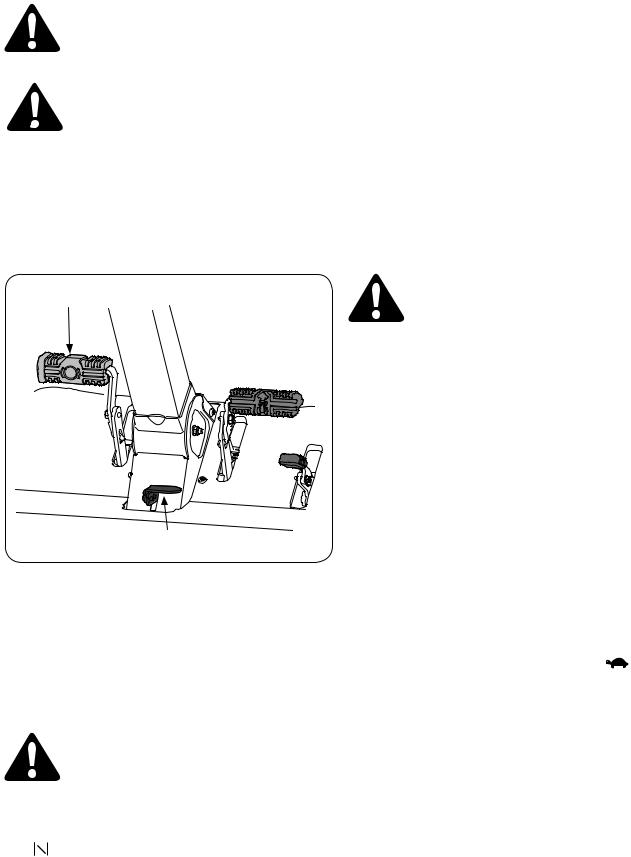
Starting the Engine
WARNING! This tractor is equipped with a safety interlock system designed for the protection of the operator. Do not operate the tractor if any part of the system is malfunctioning. Periodically check the function of the interlock system for proper operation.
WARNING! For personal safety, the operator must be sitting in the tractor seat when starting the engine.
NOTE: Refer to the Engine Operator’s Manual for oil fill-up instructions and refer to the Assembly & Set-Up section for gasoline fill-up instructions.
1.Operator must be sitting in the tractor seat.
2.Engage the parking brake by pressing forward on the brake
pedal , then press down on the parking break/cruise control lever and then release the brake pedal
, then press down on the parking break/cruise control lever and then release the brake pedal . Refer to
. Refer to
Figure 5-1.
Brake Pedal
Parking Brake/Cruise Control Lever
Figure 5-1
3.Make certain the PTO switch is in the disengaged (down) position. Refer to Figure 5-1.
4.Move the throttle/choke control into the CHOKE position.
position.
NOTE: If the engine is warmed up, it may not be necessary to place the throttle/choke control in the CHOKE position.
position.
5.Turn the ignition key clockwise to the START  position. After the engine starts, release the key. It will return to the run position.
position. After the engine starts, release the key. It will return to the run position.
CAUTION: Do NOT hold the key in the START position for longer than ten seconds at a time. Doing so may cause damage to your engine’s electric starter.
position for longer than ten seconds at a time. Doing so may cause damage to your engine’s electric starter.
6.As the engine warms up, gradually pull the throttle/choke control lever rearward past the choke detent position.
NOTE: Do NOT leave the throttle/choke control in the CHOKE
 position while operating the tractor. Doing so will result in a “rich” fuel mixture and cause the engine to run poorly.
position while operating the tractor. Doing so will result in a “rich” fuel mixture and cause the engine to run poorly.
7.Allow the engine to run for a few minutes at mid throttle before putting the engine under load.
8.Observe the hour meter/indicator panel. If the battery indicator light or oil pressure light come on, immediately stop the engine. Have the tractor inspected by your Cub Cadet dealer.
Cold Weather Starting
When starting the engine at temperatures near or below freezing, ensure the correct viscosity motor oil is used in the engine and the battery is fully charged. Start the engine as follows:
1.Be sure the battery is in good condition. A warm battery has much more starting capacity than a cold battery.
2.Use fresh winter grade fuel. Winter grade gasoline has higher volatility to improve starting. Do not use gasoline left over from summer.
3.Follow the previous instruction for Starting the Engine.
Using Jumper Cables To Start Engine
WARNING! Batteries contain sulfuric acid and produce explosive gasses. Make certain the area is well ventilated, wear gloves and eye protection, and avoid sparks or flames near the battery.
If the battery charge is not sufficient to crank the engine, recharge the battery. If a battery charger is unavailable and the tractor must be started, the aid of a booster battery will be necessary. Connect the booster battery as follows:
1.Connect the end of one cable to the disabled tractor battery’s positive terminal; then connect the other end of that cable to the booster battery’s positive terminal.
2.Connect one end of the other cable to the booster battery’s negative terminal; then connect the other end of that cable to the frame of the disabled tractor, as far from the battery as possible.
3.Start the disabled tractor following the normal starting instructions previously provided; then disconnect the jumper cables in the exact reverse order of their connection.
4.Have the tractor’s electrical system checked and repaired as soon as possible to eliminate the need for jump starting.
Stopping the Engine
1.Place the PTO switch in the disengaged position.
2.Engage the parking brake.
3. |
Move the throttle/choke control to the SLOW |
position |
|
and allow the engine to idle for about one minute. |
|
4.Turn the ignition key to the STOP position and remove the key from the ignition switch.
position and remove the key from the ignition switch.
NOTE: Always remove the key from the ignition switch to prevent accidental starting or battery discharge if the equipment is left unattended.
Section 5 — Operation |
|
17 |
|
||
|
|
|
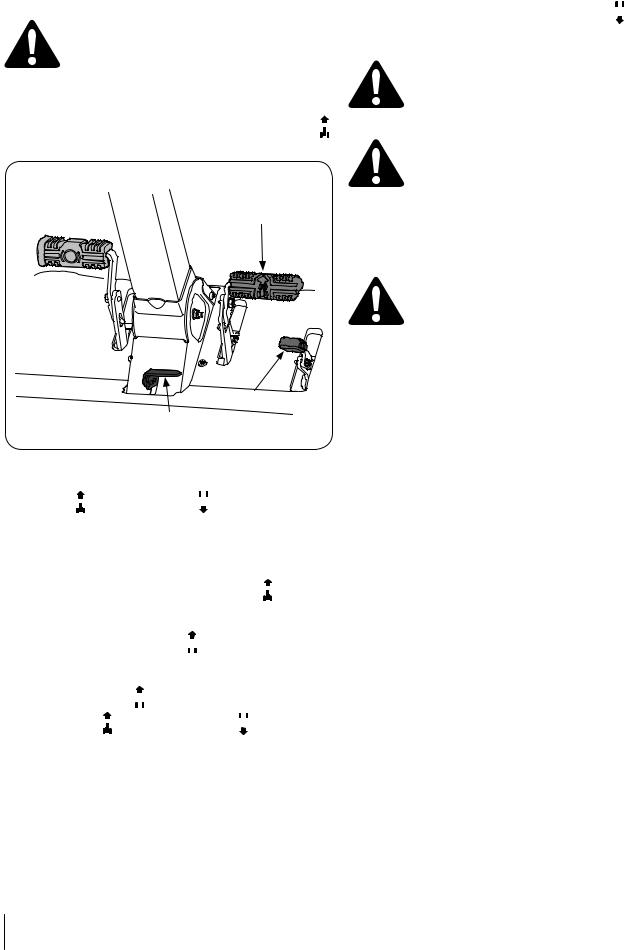
Driving The Tractor
WARNING! Avoid sudden starts, excessive speed and sudden stops.
1.Release the parking brake. Move the throttle/choke control lever into the FAST position.
position.
2.To travel FORWARD, slowly press the forward drive pedal
 forward until the desired speed is achieved. See Figure 5-2.
forward until the desired speed is achieved. See Figure 5-2.
Forward Drive Pedal
Reverse Drive Pedal
Parking Brake/Cruise Control Lever
Figure 5-2
3.To stop or slow down the tractor, take your foot off of the forward 
 or reverse drive pedal
or reverse drive pedal 
 . To lock the parking brake, press forward on the brake pedal, then press down on the parking break/cruise control lever and then release the brake pedal
. To lock the parking brake, press forward on the brake pedal, then press down on the parking break/cruise control lever and then release the brake pedal .
.
4.To use the cruise control:
a.Press down on the forward drive pedal 
 .
.
b.While maintaining the desired speed press down on the parking break/cruise control lever then release
the forward drive pedal 
 to activate the cruise control.
to activate the cruise control.
5.To release the cruise control, press the brake or the forward drive pedal
or the forward drive pedal 
 .
.
NOTE: The forward 
 and reverse drive pedals
and reverse drive pedals 
 must not be used when the brake is partially engaged. When the brake is locked the drive belt is disengaged but if the brake is only part way back then the brakes are engaged but so is the drive belt so transmission damage will occur if you push forward or reverse.
must not be used when the brake is partially engaged. When the brake is locked the drive belt is disengaged but if the brake is only part way back then the brakes are engaged but so is the drive belt so transmission damage will occur if you push forward or reverse.
6.To travel in reverse, check that the area behind is clear then slowly push forward on the reverse drive pedal 
 with the ball of your foot (NOT your heel) until the desired speed is achieved. See Figure 5-2.
with the ball of your foot (NOT your heel) until the desired speed is achieved. See Figure 5-2.
CAUTION: Do NOT attempt to change the direction of travel when the tractor is in motion. Always bring the tractor to a complete stop before moving the tractor from forward to reverse or vice versa.
WARNING! Do not leave the seat of the tractor without first placing the PTO knob in the disengaged (OFF) position and engaging the parking brake. If leaving the tractor unattended, also turn the engine off and remove the ignition key.
Driving On Slopes
Refer to the SLOPE GAUGE on page 8 to help determine slopes where you may operate the tractor safely.
WARNING! Do not mow on inclines with a slope in excess of 15 degrees (a rise of approximately 2-1⁄2 feet every 10 feet). The tractor could overturn and cause serious injury.
•Mow across slopes, not up and down.
•Exercise extreme caution when changing direction on slopes.
•Watch for holes, ruts, bumps, rocks, or other hidden objects. Uneven terrain could overturn the machine. Tall grass can hide obstacles.
•Do not turn on slopes unless necessary; then turn slowly uphill and use extra care while turning. Turning up a slope greatly increases the chance of a rollover.
•Avoid stopping when driving up a slope. If it is necessary to stop while driving up a slope, start up smoothly and carefully to reduce the possibility of flipping the tractor over backward.
18 Section 5— Operation
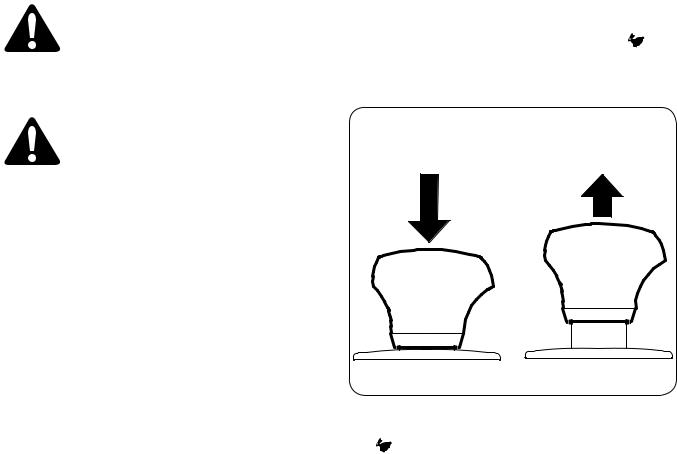
Mowing
WARNING! To help avoid blade contact or a thrown object injury, keep bystanders, helpers, children and pets at least 75 feet from the machine while it is in operation. Stop machine if anyone enters the area.
The following information will be helpful when using the cutting deck with your tractor.
WARNING! Plan your mowing pattern to avoid discharge of materials toward roads, sidewalks, bystanders and the like. Also, avoid discharging material against a wall or obstruction which may cause discharged material to ricochet back toward the operator.
•Do not mow at high ground speed, especially if a mulch kit or grass collector is installed.
•Do not cut the grass too short. Short grass is prone to weed growth and yellows quickly in dry weather.
•Always operate the tractor with the throttle/choke control lever in the FAST position while mowing.
position while mowing.
•For best results it is recommended that the first two laps be cut with the discharge thrown towards the center. After the first two laps, reverse the direction to throw the discharge to the outside for the balance of cutting. This will give a better appearance to the lawn.
•Do NOT attempt to mow heavy brush and weeds or extremely tall grass. Your tractor is designed to mow lawns,
NOT clear brush.
•Keep the blades sharp and replace the blades when worn.
Manual Lift Lever
To raise or lower the cutting deck, move the lift lever to the left, then place it in the notch best suited for your application.
Engaging the PTO
Engaging the PTO transfers power to the cutting deck or other (separately available) attachments. To engage the PTO:
1.Move the throttle/choke control lever to the FAST position.
2.Pull the PTO/Blade Engage knob outward into the engaged (ON) position. See Figure 5-3.
OFF ON
Figure 5-3
NOTE: Always operate the tractor with the throttle lever in the FAST position for the most efficient use of the cutting deck or other (separately available) attachments.
Section 5 — Operation |
|
19 |
|
||
|
|
|
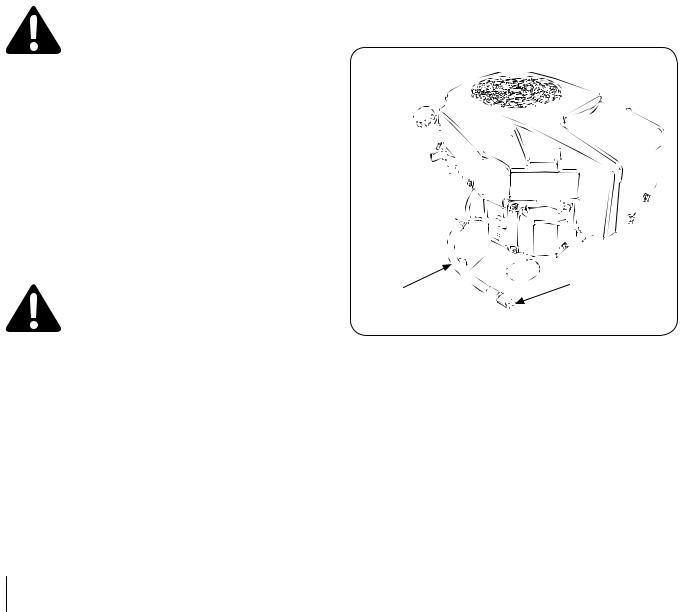
Maintenance & Adjustments |
|
|
|
|
|
|
6 |
|
|
|
|
|
|
|
|
|
|
|
|
Maintenance Schedule |
|
|
|
|
|
|
|
|
|
|
Before |
|
Every |
|
Every |
|
Prior |
|
|
|
|
|
|
|
|||||
|
Each use |
|
10 Hours |
|
25 Hours |
|
to Storing |
|
|
Clean Battery Terminals |
|
|
P |
|
|
|
P |
|
|
|
|
|
|
|
|
|
|
|
|
|
|
|
|
|
|
|
|
|
|
Lube Front Caster Wheels and Wheel Spindles |
|
|
|
|
P |
|
P |
|
|
|
|
|
|
|
|
|
|
|
|
|
|
|
|
|
|
|
|
|
|
Check Engine Cooling Fins for Debris (Clean as |
P |
|
|
|
|
|
P |
|
|
Necessary) |
|
|
|
|
|
|
|||
|
|
|
|
|
|
|
|
|
|
Lube Pedal Pivot Points |
|
|
P |
|
|
|
P |
|
|
|
|
|
|
|
|
|
|
|
|
|
|
|
|
|
|
|
|
|
|
Grease Front Castings |
|
|
|
|
P |
|
|
|
|
|
|
|
|
|
|
|
|
|
|
|
|
|
|
|
|
|
|
|
|
Maintenance
WARNING! Before performing any maintenance or repairs, disengage PTO, set parking brake, stop engine and remove key to prevent unintended starting.
4.While holding the free end of the oil drain hose over the oil collection container, unscrew the square head hose plug from the end of the hose. See Figure 6-1. Drain the engine oil into the collection container.
Hydrostatic Transmission
The hydrostatic transmission is sealed at the factory and is maintenance-free. The fluid level cannot be checked and the fluid cannot be changed.
Engine
Refer to the Kohler Owner’s Manual for all engine maintenance procedures and instructions.
NOTE: Maintenance, repair, or replacement of the emission control devices and systems which are being done at owner’s expense may be performed by any engine repair establishment or individual. Warranty repairs must be performed by a Cub Cadet Dealer.
Changing the Engine Oil
WARNING! If the engine has been recently run, the engine, muffler and surrounding metal surfaces will be hot and can cause burns to the skin. Exercise caution to avoid burns.
To complete an oil change, proceed as follows:
1.Run the engine for a short time to warm the engine oil. The oil will flow more freely and carry away more impurities. Use care to avoid burns from hot oil.
2.Locate the oil drain port on the right side of the engine.
3.Route the free end of the oil drain hose toward an appropriate oil collection container with at least a 2.5 quart capacity, to collect the used oil. Remove the oil fill cap/ dipstick from the oil fill tube.
|
|
Square-Head |
|
Oil Drain Hose |
|||
Hose Plug |
|||
Figure 6-1
5.After draining the oil, wipe any residual oil from the oil drain hose. Thread the square head plug into the drain hose fitting and fully tighten the plug.
6.Replace the oil filter, and refill the engine with new oil as instructed in the Kohler Owner’s Manual.
20

Battery
CALIFORNIA PROPOSITION 65 WARNING!
Battery posts, terminals, and related accessories contain lead and lead compounds, chemicals known to the State of California to cause cancer and reproductive harm. Wash hands after handling.
The battery is sealed and is maintenance-free. Acid levels cannot be checked and fluid can not be added.
•Always keep the battery cables and terminals clean and free of corrosive build-up.
•After cleaning the battery and terminals, apply a light coat of petroleum jelly or grease to both terminals.
CAUTION: If removing the battery for cleaning, disconnect the NEGATIVE (Black) wire from its terminal first, followed by the POSITIVE (Red) wire. When reinstalling the battery, always connect the POSITIVE
(Red) wire its terminal first, followed by the NEGATIVE
(Black) wire. Be certain that the wires are connected to the correct terminals; reversing them could result in serious damage to your engine’s alternating system.
Battery Storage
1.When storing the tractor for extended periods, disconnect the negative battery cable. It is not necessary to remove the battery.
2.All batteries discharge during storage. Keep the exterior of the battery clean, especially the top. A dirty battery will discharge more rapidly.
3.The battery must be stored with a full charge. A discharged battery can freeze sooner than a charged battery. A fully charged battery will store longer in cold temperatures than hot.
4.Recharge the battery before returning to service. Although the tractor may start, the engine charging system may not fully recharge the battery.
Tractor Storage
If your tractor is not going to be operated for an extended period of time (thirty days to approximately six months), the tractor should be prepared for storage. Store the tractor in a dry and protected location. If stored outside, cover the tractor (including the tires) to protect it from the elements. The procedures outlined below should be performed whenever the tractor is placed in storage.
1.Change the engine oil and filter following the instructions provided in the engine manual packed with this manual.
WARNING! Never store the tractor with fuel in the tank indoors or in poorly ventilated enclosures, where fuel fumes may reach an open flame, spark or pilot light as on a furnace, water heater, clothes dryer, etc.
2.If storing the tractor for 30 days or more:
a.To prevent gum deposits from forming inside the engine’s carburetor and causing possible
malfunction of the engine, the fuel system must be either completely emptied, or the gasoline must be treated with a stabilizer to prevent deterioration.
WARNING! Fuel left in the fuel tank deteriorates and will cause serious starting problems.
b.Using a fuel stabilizer such as STA-BIL® for storage between 30 and 90 days:
•Read the product manufacturer’s instructions and recommendations.
•Add to clean, fresh gasoline the correct amount of stabilizer for the capacity
(approximately 3 gallons) of the fuel system.
•Fill the fuel tank with treated fuel and run the engine for 2-3 minutes to get stabilized fuel into the carburetor.
c.Emptying the fuel system for storage of more than
90 days:
•Prior to putting the tractor in storage, monitor fuel consumption with the goal of running the fuel tank empty.
•Run the engine until it begins to stall. Use the choke to keep the engine running until all fuel in the carburetor has been exhausted.
•Referring to the engine manual, drain the fuel from the carburetor bowl.
3.Clean the engine and the entire tractor thoroughly.
4.Fully charge the battery, then disconnect the negative cable at the battery to prevent possible discharge. Recharge the battery periodically when in storage.
NOTE: Remove the battery if exposed to prolonged periods of sub-freezing temperatures. Store in a cool, dry location where temperatures are above freezing.
5.Lubricate all lubrication points.
NOTE: Using a pressure washer or garden hose is not recommended for cleaning your tractor. It may cause damage to electrical components, spindles, pulleys, bearings or the engine. The use of water will result in shortened life and reduce serviceability.
Removing The Tractor From Storage
1.Check the engine oil.
2.Fully charge the battery and inflate the tires to the recommended pressure.
3.If drained before storing, fill the fuel tank with clean, fresh gasoline.
4.Add clean, fresh fuel.
5.Start the engine and allow to idle for a few minutes to ensure engine is operating properly.
6.Drive the tractor without a load to make certain all the tractor systems are functioning properly.
Cleaning the Tractor
Any fuel or oil spilled on the machine should be wiped off promptly. Do NOT allow debris to accumulate around the cooling fins of the engine, the transmission’s cooling fan or on any other part of the machine, especially the belts and pulleys.
Smart Jet™
Your tractor’s deck is equipped with a water port on its surface as part of its deck wash system.
Section 6 — Maintenance & Adjustments |
|
21 |
|
||
|
|
|

Use the Smart Jet™ to rinse grass clippings from the deck’s underside and prevent the buildup of corrosive chemicals.
Complete the following steps AFTER EACH MOWING:
1.Drive the tractor to a level, clear spot on your lawn, near enough for your garden hose to reach.
CAUTION: Make certain the tractor’s discharge chute is directed AWAY from your house, garage, parked cars, etc.
1.Disengage the PTO (Blade Engage), set the parking brake and stop the engine.
2.Thread the hose coupler (packaged with your tractor’s Operator’s Manual) onto the end of your garden hose.
3.Attach the hose coupler to the water port on the left of your deck surface. See Figure 6-2.
Nozzle Adapter

 Adapter Lock Collar
Adapter Lock Collar
Deck Wash Nozzle
Figure 6-2
4.Turn the water on.
5.While sitting in the operator’s position on the tractor, start the engine and place the throttle lever in the FAST position.
position.
6.Engage the PTO.
7.Remain in the operator’s position with the cutting deck engaged for a minimum of two minutes, allowing the underside of the cutting deck to thoroughly rinse.
8.Disengage the PTO.
9.Turn the ignition key to the STOP position to turn the tractor’s engine off.
position to turn the tractor’s engine off.
10.Turn the water off and detach the hose coupler from the water port on your deck’s surface.
11.After cleaning your deck with the Smart Jet™ system, return to the operator’s position and engage the PTO. Keep the cutting deck running for a minimum of two minutes, allowing the underside of the cutting deck to thoroughly dry.
Lubrication
WARNING! Before lubricating, repairing, or inspecting, always disengage PTO, set parking brake, stop engine and remove key to prevent unintended starting.
Front Wheels
Each of the front wheel axles and rims is equipped with grease fittings. See Figure 6-3. Lubricate with a No. 2 multi-purpose grease applied with a grease gun after every 25 hours of tractor operation.
Grease
Fittings
Figure 6-3
Steering Supports
Under the frame of the tractor there are two grease fittings for the steering supports. Lubricate with a No. 2 multi-purpose grease applied with a grease gun after every 25 hours of tractor operation. See Figure 6-4.
Grease
 Fitting
Fitting
|
Figure 6-4 |
|
Pivot Points & Linkage |
|
Lubricate all the pivot points on the drive system, parking brake |
22 |
and lift linkage at least once a season with light oil. |
Section 6— Maintenance & Adjustments |
|
|
|

Tires
WARNING! Never exceed the maximum inflation pressure shown on the sidewall of the tire.
Refer to the tire sidewall for exact tire manufacturer’s recommended or maximum psi. Do not overinflate. Uneven tire pressure could cause the cutting deck to mow unevenly.
Adjustments
NOTE: Check the tractor’s tire pressure before performing any deck leveling adjustments. Refer to Tires above for information regarding tire pressure.
WARNING! Shut the engine off, remove the ignition key and engage the parking brake before making adjustments. Protect your hands by using heavy gloves when handling the blades.
Leveling the Deck (Side to Side)
NOTE: Check the tractor’s tire pressure before performing any deck leveling adjustments. Refer to Tires for information regarding tire pressure. Always level the deck side to side before front to rear.
If the cutting deck appears to be mowing unevenly, a side to side adjustment can be performed. Adjust if necessary as follows:
1.With the tractor parked on a firm, level surface, place the deck lift handle in a middle mowing position and rotate both outside blades so that they are perpendicular with the tractor.
2.Measure the distance from the outside of the left blade tip to the ground and the distance from the outside of the right blade tip to the ground. Both measurements taken should be equal. If they’re not, proceed to the next step.
3.Loosen, but do NOT remove, the hex bolt on the rear left deck hanger link. See Figure 6-5.
Adjustment
Gear
Hex Bolt
Figure 6-5
NOTE: The rear right deck hanger link is not adjustable and is used to help adjust the other hanger links.
4.Using a wrench, raise or lower the left side of the deck by turning the adjustment gear. See Figure 6-5.
5.The deck is properly leveled when both blade tip measurements are equal. Retighten the hex bolt on the front left deck hanger bracket when proper adjustment is achieved.
Leveling the Deck (Front To Rear)
NOTE: Check the tractor’s tire pressure before performing any deck leveling adjustments. Refer to Tires on page 22 for
information regarding tire pressure. Always level the deck side to side before front to rear.
The front of the deck should be between 1⁄4” and 3⁄8” lower than the rear of the deck. Adjust if necessary as follows:
1.Park the tractor on a firm, level surface and place the deck lift handle in a middle position.
2.Rotate the blade nearest the discharge chute so that it is parallel with the tractor.
3.Measure the distance from the front of the blade tip to the ground and the rear of the blade tip to the ground. The first measurement taken should be between 1⁄4” and 3⁄8” less than the second measurement.
4.Determine the approximate distance necessary for proper adjustment and proceed, if necessary.
5.Using a wrench, raise or lower the front of deck by turning lock nut on the front deck lift rod. See Figure 6-6.
Lock Nut
Front Deck Lift Rod
Figure 6-6
6.The deck is properly leveled when the front tip of the blade is 1⁄4” lower than the rear tip. Retighten the hex bolt on the left and right rear deck hanger links when proper adjustment is achieved.
Section 6 — Maintenance & Adjustments |
|
23 |
|
||
|
|
|
